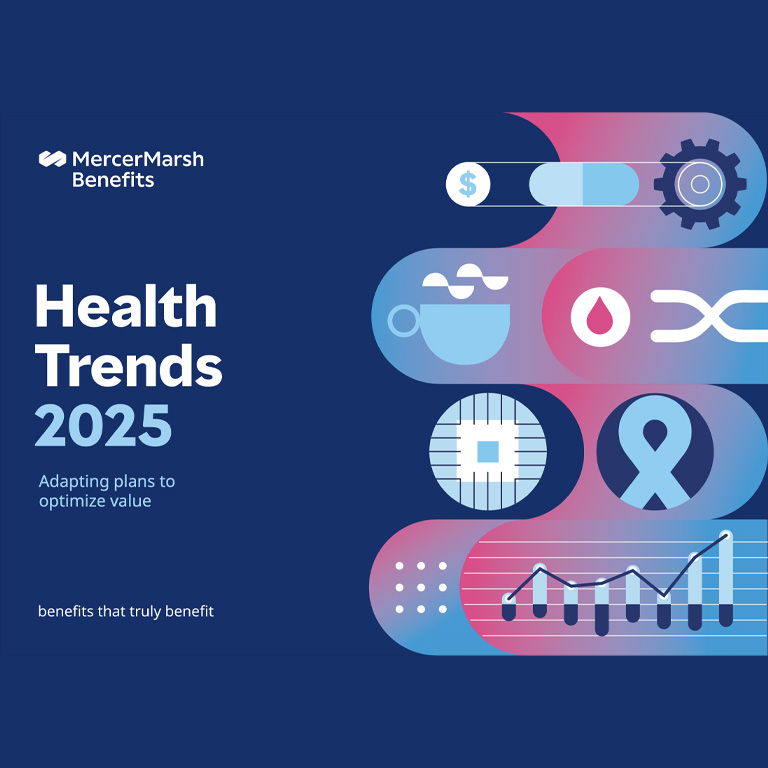
By Dr. Octavio Gascón Enriquez MD, PsyD, MS ,
Emotional Wellbeing Manager, Mercer Marsh Benefits
24/03/2022 · 4 min 30 sec
In part, this escalation was driven by the spread of COVID-19. Measures such as self-isolation and quarantine led to increases in contributing factors, including loneliness, worry, insomnia, self-harm and domestic violence.
At the same time, many employees are experiencing new stressors in their everyday lives, with Gen Z and millennials particularly affected. A research paper published in the International Journal of Environmental and Public Health tracked stress, anxiety and depression symptoms throughout the pandemic. The study found perceived symptoms were far higher among people age 25 and under and lowest among those over 60. The mean scores decreased with every shift from a younger bracket to an older one.
Across all demographics, financial worries have increased dramatically due to global economic crises, inflation and cost-of-living increases. Lack of job security and fear of redundancies have also been significant concerns for many. A study by the American Psychological Association found that Americans struggling through greater financial stress are more likely to present problematic stress-coping styles, such as smoking or drinking.[1]
Worse, the pandemic also disrupted the delivery of mental health services, making it harder for people to seek treatment, support and early intervention. Because many countries failed to accomplish the goals outlined by the World Health Organization in its Mental Health Action Plan 2013–2020, most were not prepared for these mental health challenges.[2]
It is hardly surprising that this increase in mental health issues is having a ripple effect on medical claims costs across the globe. In MMB’s 2021 Health Trends research, insurers identified COVID-19 and emotional or mental risk as the top influencers of employer-provided medical plan costs.
But costs are not the only reason employers should be concerned about the mental welfare of their workforces. Poor mental health can lead to increased absences, lower productivity and high staff turnover. Workplace environments that contribute to stress will increasingly be a source of reputational damage. They can also contribute to serious incidents involving misconduct, errors and omissions, and safety issues, including workplace violence due to cognitive impairment as a result of unmanaged stress.
The good news is that opportunities to fill the gaps in medical plans and provide mental healthcare to the workforce will continue during 2022. Employers can do the right thing and meet growing societal obligations while also protecting the health of their businesses.
According to our medical trends research, the number of insurers providing mental health support has increased. Just one in four insurers (26%) does not provide any mental health cover, compared to one in three (32%) last year.[3]
And our Health on Demand research shows that workers increasingly turn to their employers as trusted providers of health support. Indeed, mental health provision is a core differentiator, which can boost talent acquisition and retention. (This research shows that 42% of employees with access to mental health benefits are less likely to leave the company compared to 27% of those without access). Equally, people whose employers provide a wide range of health and well-being benefits are more loyal, more engaged and less likely to leave a company.
We found strong indicators of the benefits that employees value most. Half of employees say they would value insurance coverage to reduce the cost of mental health treatment. However, employers need to ensure that mental health solutions cover the full care continuum so individual needs can be met.
For example, our Health Trends Report reveals:
Across the globe, employers have an opportunity to make a meaningful difference in people’s lives by investing in mental health programs.
Many organizations are implementing mental-health-specific components as crucial aspects of their overall health and well-being strategies. Although health education is only part of the solution, it is an important element and can include workshops on topics such as stress management, conflict resolution, assertiveness, effective communication, relationship and psychological first aid, and more. For example, MMB’s team in Mexico is helping organizations implement diversity and inclusion webinars for their employees and leadership training sessions around inclusivity in the workplace, along with organizational diversity and inclusion discovery surveys to assess the types of actions needed.
Insurance is one solution, but employers should ensure that cost of care is not a barrier. This means providing early interventions and, where possible, creating a culture of health that addresses mental well-being before treatment is required.
This starts with a comprehensive mental health strategy that includes peer/supervisor support, healthy corporate culture, and targeted solutions that supplement the employee assistance program.
Employers who provide these interventions to support the mental health of employees will be more likely to benefit from improvements in managed claims experience and in general business risk. Providing such solutions also helps with the important process of destigmatizing mental health in the workplace.
[1] American Psychological Association. Stress in America: Paying With Our Health, 2015, available at https://www.apa.org/news/press/releases/stress/2014/financial-stress.
[2] World Health Organization. Mental Health Action Plan 2013–2020, 2013, available at https://apps.who.int/iris/bitstream/handle/10665/89966/9789241506021_eng.pdf.
[3] Ibid.

Report
06/01/2025